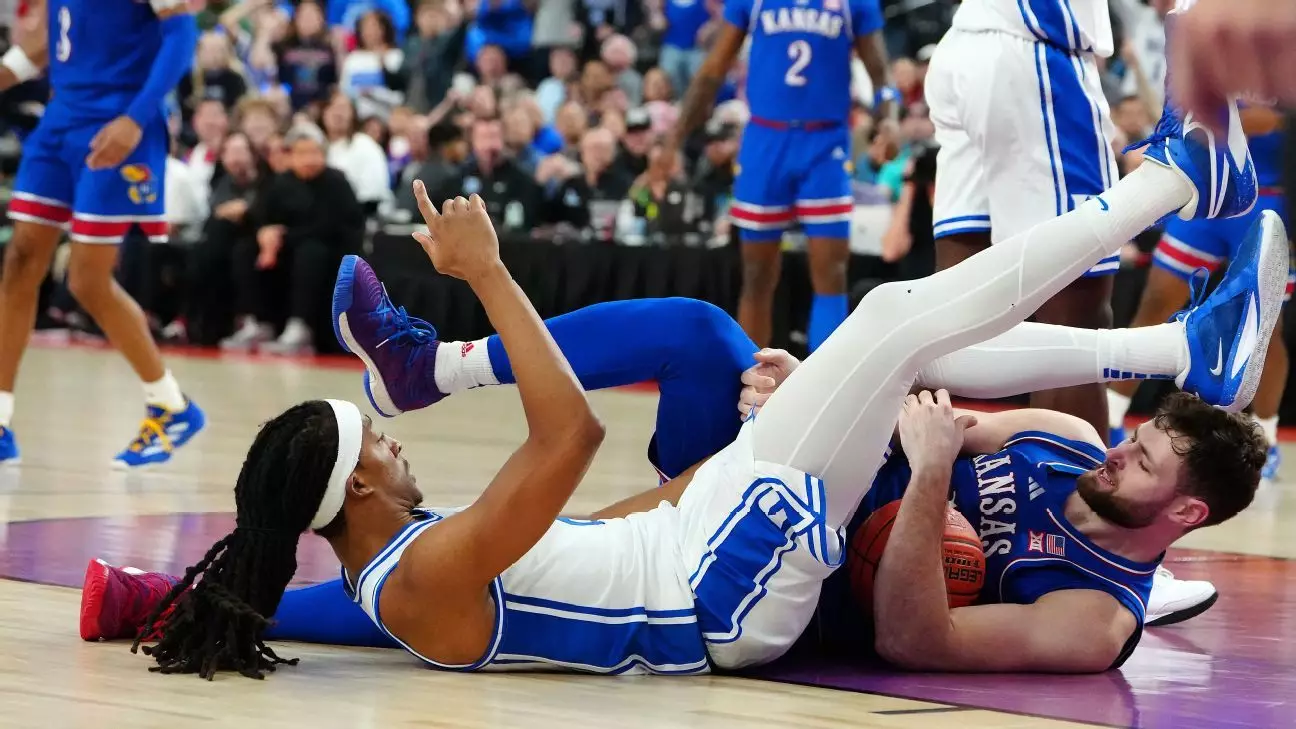In the fast-paced world of college basketball, pivotal moments can shift the momentum of a game in an instant. The recent clash between the No. 1 Kansas Jayhawks and No. 11 Duke Blue Devils at the T-Mobile Arena in Las Vegas is a prime example of this phenomenon. This match not only showcased the skills and strategies of both teams but also emphasized the profound impact that player ejections can have on the outcome of high-stakes basketball games. Central to this narrative is Kansas’ star center, Hunter Dickinson, whose ejection generated significant discussion regarding officiating and its consequences.
The intensity of the game reached a boiling point when Hunter Dickinson was ejected after a controversial incident involving Duke’s Maliq Brown. The ejection occurred with just over ten minutes left in the second half, during a moment where both players were vying for a rebound on the floor. Dickinson, ironically a player known for his offensive prowess and rebounding skills, had just missed a jump shot. In the heat of the competition, he inadvertently kicked Brown in the face while attempting to disentangle himself from the play, leading the officials to assess the situation and subsequently assign a flagrant foul 2.
This decision drew immediate reactions not only from the players but also from both coaches. Kansas head coach Bill Self remarked on the call, acknowledging its potential severity yet suggesting the flagrant 2 ruling might have leaned too heavily on the aspect of intentionality. Herein lies a critical discussion point surrounding officiating in basketball: the intersection of intent and consequence. While Dickinson’s action was undoubtedly reckless, it prompts the question of where to draw the line between a moment of poor judgment and an intentional attempt to harm an opponent.
With Dickinson’s departure, Kansas faced an immediate challenge—not only in adjusting their strategy but also in rallying team morale. His ejection occurred during a tightly contested match where Kansas held a narrow lead. The Jayhawks had to adapt without their leading scorer, who averaged almost 18 points per game at that point in the season. Their response was commendable, showcasing the depth of their lineup. Backup center Flory Bidunga rose to the occasion, contributing significantly in his time on the court, recording 6 points and 8 rebounds.
The ability of junior guard Rylan Griffen to hit crucial shots, including a timely three-pointer following Dickinson’s ejection, underlines the importance of having versatile players who can step up in high-pressure situations. This moment not only highlights Kansas’ collective resilience but also throws light on the unpredictable nature of basketball. The emotional volatility following an ejection can have repercussions extending beyond gameplay—creating a sense of urgency and fostering brotherhood amongst players striving to earn a hard-fought victory.
Beyond the final score, Hunter Dickinson’s ejection may have broader implications for future games. As Coach Self suggested, this incident could serve as a valuable lesson for Dickinson and his teammates going forward. The aftermath highlights the necessity for players to maintain composure, focusing on the game’s objectives rather than becoming embroiled in individual conflicts. Meanwhile, the reaction from Duke’s coach Jon Scheyer, who supported the ejection, reflects a growing consensus in sports regarding player safety and respect for the game.
The discussions around officiating standards and the technological integration of video reviews can reshape future encounters. As basketball continues to evolve, the balance between a game’s physicality and its sportsmanship will remain a crucial focal point. Such incidents serve as reminders for athletes at every level about their responsibilities on and off the court.
The ejection of Hunter Dickinson during the Kansas vs. Duke matchup is not just an isolated event; it casts a spotlight on the dynamics of college basketball as a whole. Understanding its implications offers insights into how teams adapt to adversity, the role of officiating, and ultimately, the human aspects of sportsmanship that dictate the essence of the game.


Leave a Reply